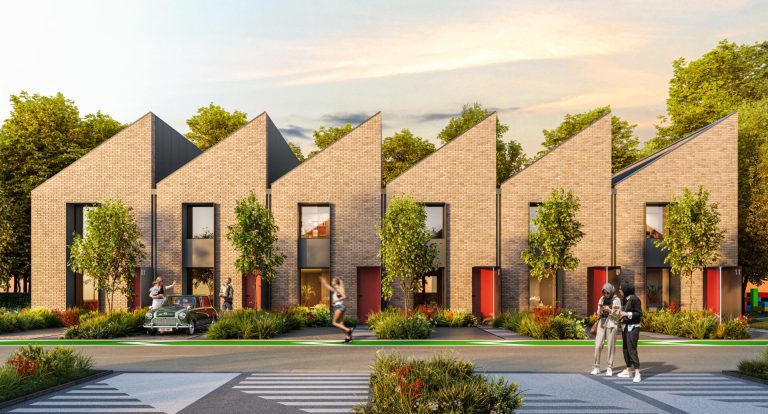Homes for Scotland (HFS), the leading representative body for the Scottish home building sector, is calling for a rethink across government and wider society on how to address the spiralling housing crisis. Launching its new five-year strategy ‘Home building as a force for good’ today (Friday) and in the context of a 110,000 homes shortfall with a worrying downward trend in the number of new homes being started, theorganisation wants better local and national government collaboration and the voices of the silent majority heard in order to tackle Scotland’s chronic undersupply of housing across all tenures. In addition to the 110,000 homes shortfall which has accumulated since 2008, latest Scottish Government figures show a decline of 12% in home building starts overall and a 27% reduction in social housing approvals. Chief Executive Jane Wood said: “Having accumulated a shortfall of 110,000 homes since 2008, Scotland’s housing crisis is well recognised. Just as this affects us all, so it is up to each and every one of us to take responsibility for ensuring that we have enough homes for those who need them now and for future generations. “From health and education to jobs and investment, housing impacts every area of our lives and is key to advancing social justice and tackling inequality, but we simply don’t have enough homes. “Unfortunately, home building is a hugely politicised and contentious issue and I’m calling on those of us who already have homes to be more supportive of those who don’t. “Delivery challenges across the sector have never been greater, from rising costs and skills shortages to planning delays and changes to building standards as part of the transition to net zero. These barriers are now making it harder than ever to build new homes in Scotland. Our sector is not able to compete on a level playing field compared to elsewhere in the UK. “SME builders, in particular, are bearing the brunt with their numbers having already declined significantly and with the viability of many projects in doubt, some smaller home builders have abandoned home building plans altogether. “The housing crisis has already had a drastic and far-reaching impact on Scotland’s economic and social development. If we don’t get this sorted, the consequences on the life chances of future generations will be even worse.” On average, major housing applications are taking 39 weeks to reach a decision from the time of registration. The national target for determining major housing applications is 16 weeks. As well as the barriers relating to planning and regulation, negative perceptions of home building also have far-reaching consequences, impacting the sector’s ability to get on with delivering more homes. Misinformation and opposition to new developments continues to have an effect but, in reality, only 2.1% of land in Scotland is built upon, the lowest level in the UK. “I am asking us all to pause and reflect before condemning the building of new homes, recognising the urgent and critical need that exists right across the spectrum. It’s time to embrace the benefits new homes bring and for the voices of the silent majority to be heard by those who influence and direct local and national policy. “We need urgent action with better collaborative working between key players to solve what is a chronic issue and help stimulate growth.” New complex regulations like the National Planning Framework 4 as well as costly, time-consuming and difficult consent processes are all making it more difficult for developers to build new homes. HFS wants to facilitate joined-up and partnership approaches with the Scottish Government, local authorities and stakeholders to facilitate housing delivery and ensure policies and regulation are implemented appropriately, fairly and in support of much needed homes. Speaking ahead of the organisation’s strategy launch at the annual HFS awards today Jane Wood continued: “We must have a policy environment that supports development rather than frustrating it and one which attracts investment otherwise we will stymie our ambitions and damage the potential of our towns, cities and rural communities. “Above all else, policy-making must be informed by contextual data and market insight to avoid unintended consequences across other National Outcomes.” Accurate and current data from government and local authorities is crucial to creating a more authentic picture of the actual need for new homes in Scotland. However, this is very much a missing piece of the housing jigsaw, with its absence obscuring the true picture of housing need. HFS plans to work with the Scottish Government, local authorities and its members to create relevant data sets to ensure the homes that are needed are delivered on the ground, not just on paper. The new HFS strategy highlights the organisation’s aim to lead the conversation on the move to net zero carbon housing through the development of a clear road map to support the transition, working with members to achieve targets on timescales that are commercially realistic through the creation of a Scottish Future Homes Hub. Today’s Homes for Scotland’s awards support this with a focus on ‘People, Place, Planet’, highlighting the sector’s social, sustainable and environmental goals. Jane Wood concludes: “Building the homes our country requires is undoubtedly a difficult and complex job, but the undisputed fact is that home builders of all tenures are committed to playing a critical part in what is the most basic of humanitarian activities. “That is why I am making it my mission to ensure this is an issue that we all own. How each of us reacts to the building of much-needed new homes is vital to not only end our housing crisis but also to help eradicate homelessness and child poverty, tackle climate change and promote inclusive growth. Only once everyone has a place to call home will these goals be achieved. Faisal Choudhry, Head of Savills Scotland Residential Research, said: “Homes for Scotland’s latest five-year strategy covers a wide range of issues facing the supply of new homes. Its launch comes amid an array of supply and production constraints facing the














